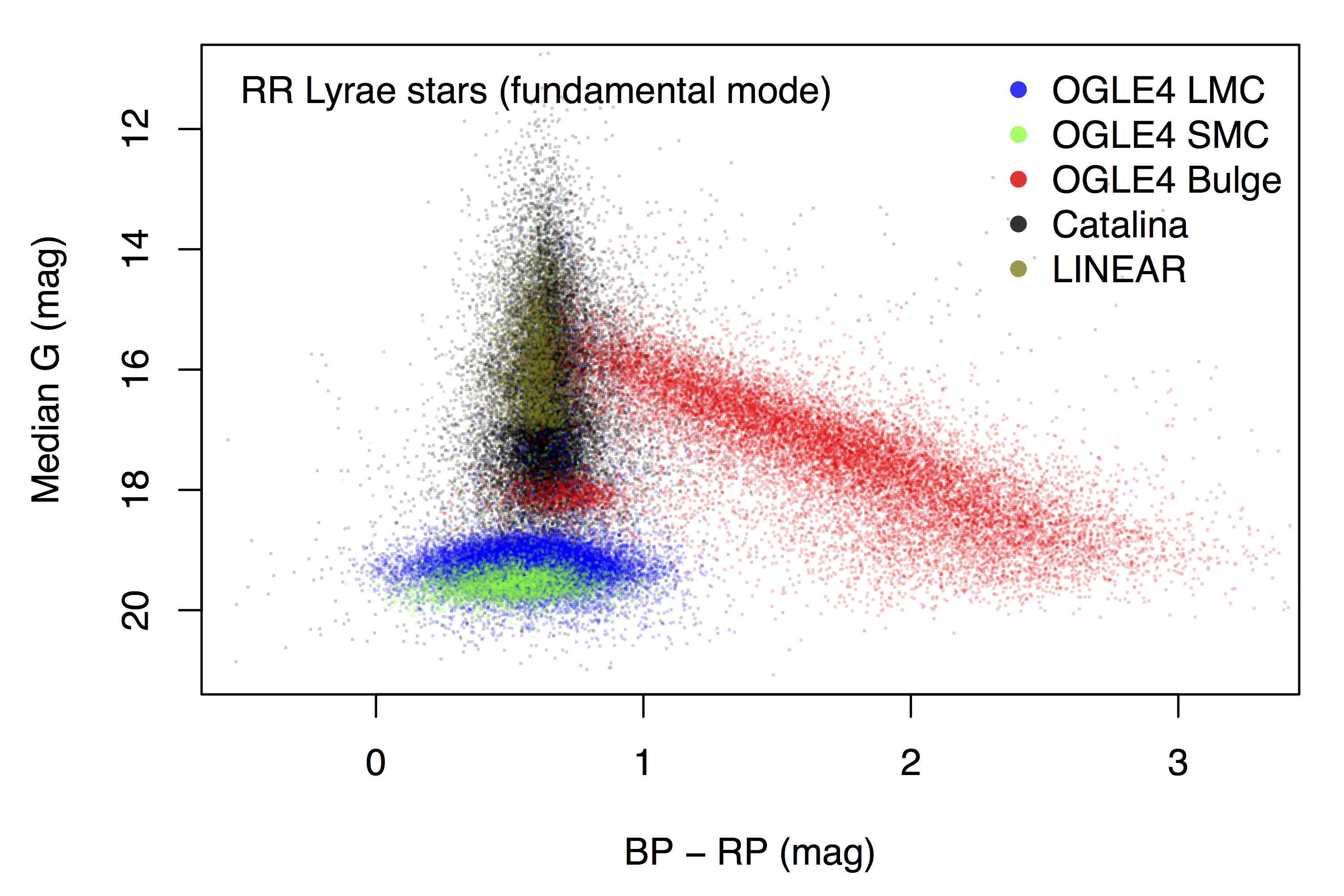IoW_20170324 - Gaia
Image of the Week |
Pulsating stars to study galactic structures |
 |
|
Figure 1: Colour-(apparent) magnitude diagram, in Gaia passbands of known fundamental mode (ab-type) RR Lyrae stars. Magnitudes and colours are not corrected for extinction. The colours indicate the other surveys that have identified these RR Lyrae stars. (Image credit: ESA/Gaia/DPAC) |
|
Pulsating stars can and have been used to study galactic structures. One group of pulsating variable stars are the RR Lyrae stars, which have been studied in various surveys such as OGLE (Soszyńcski et al. 2014, 2016), Catalina (Torrealba at al. 2015, Drake et al. 2013a, 2013b, 2014), and LINEAR (Palaversa et al. 2013). In Figure 1 a colour-(apparent) magnitude diagram of 71 464 known RR Lyrae stars (Bailey's ab-type) is shown. Data on these RR Lyrae stars can also be found in the Gaia DR1 Catalogue, although colours will only be available from Gaia DR2 onwards (and are here with a preliminary reduction). The OGLE, Catalina and LINEAR surveys have been cross-matched with the Gaia catalogue allowing us to obtain a homogeneous set of magnitudes and colours from G, BP, and RP photometry. As RR Lyrae variables can be used as standard candles, interesting structures are revealed in this diagram of apparent magnitude versus colour. First of all, it can be seen that the black and brown points, corresponding to the Catalina and LINEAR surveys respectively, produce a vertical structure that traces the Galactic halo. In the diagram some over-densities are discerned. Following the release of Gaia DR2 it would be most interesting to see if these over-densities are due to streams or are spatially clumped structures. Looking in more detail at the data available from the OGLE survey, three groups are distinguished and shown in red, green and blue. The diagonal structure in red is caused by interstellar extinction, which attenuates and reddens the light of (RR Lyrae) stars in the direction of the Bulge. The small clump in red (with G ~ 18 mag) includes primarily RR Lyrae stars from the Sagittarius dwarf spheroidal galaxy at a heliocentric distance of about 25kpc. Finally the blue and green points correspond to the RR Lyrae stars in the Large and Small Magellanic Clouds (LMC and SMC). Notice that the LMC is closer than the SMC, with a difference in distance modulus of about 0.5 magnitude, and both galaxies show a much larger spread in colour indices than the halo ones. |
 |
|
Figure 2: Sky distribution in Galactic coordinates of the cross-matched RR Lyrae stars, colour-coded with apparent magnitude, as with distance (though not accounting for extinction) (Image credit: ESA/Gaia/DPAC) |
|
In Figure 2 the Magellanic clouds (high-density red points in the southern Galactic hemisphere), the Sagittarius tidal streams (extended structures with low-density red points), and the Sagittarius dwarf spheroidal galaxy (yellow points around Galactic latitude -14 degrees and longitude +6 degrees) are clearly visible. |
|
Credits: ESA/Gaia/DPAC, Lorenzo Rimoldini, Laurent Eyer, Gisella Clementini, Vincenzo Ripepi, Marco Riello, Dafydd W. Evans and the whole CU7/DPCG team. [Published: 24/03/2017] |
- Removed a total of (7) style text-align:center;
- Removed a total of (1) border attribute.
- Removed a total of (1) cellpadding attribute.
- Removed a total of (1) cellspacing attribute.
Image of the Week Archive
- Removed a total of (1) border attribute.
- Removed a total of (1) cellpadding attribute.
- Removed a total of (1) cellspacing attribute.








































 Sign in
Sign in
 Science & Technology
Science & Technology